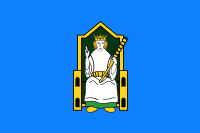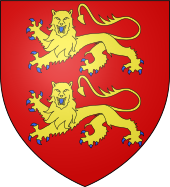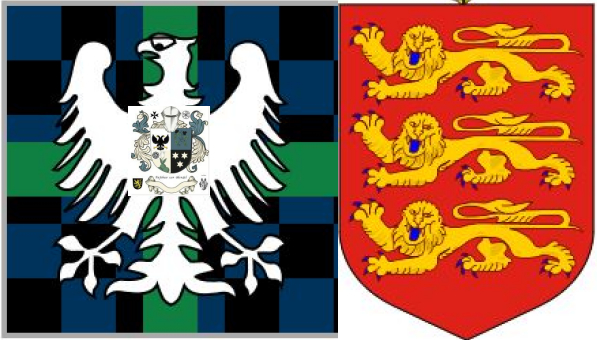The Honour of Annaly Longford - Baron
Annaly - Feudal Principality
Dossier of the Grant of Feudal Seignory and Honour of Annaly and
Longford :
The GRANT to
George Mentz (Seigneur of Fief Blondel) of: All and Singular*/Each and Every of:
The Ancient Barony, Barony, Honour, Lordship, Seignory, of
Longford or The Annaly Region of Ireland together with: (ALL
Rights, Privileges, & Perquisites) are granted and conveyed to Dr/Jur. George Mentz, Seigneur of Fief
Blondel in Aug 2018, transferred from the: Original sale of rights by The Earl of Westmeath William Anthony
Nugent Feb. 7th, 1996. The deed was
registered in the Registry of Deeds (Dublin) on 26 March 1997, Book 42, No. 266.
In plain terms, this title and deed
includes:
-
Feudal Barony, Honour, and Lordship title — the dignity, style, and title
associated with the Barony of Longford (sometimes called the Honour or Seignory) to any titles,
honors, or rights within the County Longford which is essentially the same territory as the
Kingdom of Annaly and the Kingdom of Teffia.
-
Rights and Privileges — traditional manorial or seignorial rights
historically attached to the barony (juridical, administrative, or honorary in nature).
-
Perquisites — any residual profits or incidental rights historically linked
to the Barony (e.g. rights of presentation, manorial revenues, or ceremonial precedence).
-
Fee Simple Ownership — the title is conveyed outright and heritable, not
as a tenancy or life interest.
CONVEYANCE OF FEUDAL TITLE BARONY AND
SEIGNORY
The Purchase of said rights to "County
Longford's" Honours Lordships, Seignorys, Feudal Barony, Baron Palatine, and
Perquisites in Fee Simple by George Mentz Esq. includes the right to the Honour and Seignory/Barony by any
name it may be called or known. The Feudal Lordships & Seignory of Co. Longord may be one of the most
interesting ancient principalities and baronies in Irish-Anglo-Norman History. The 1996 deed transfers
“all rights, privileges, and perquisites” — which would include any surviving
palatine or quasi-regalian rights.

History evidences that the
Kingdom of Meath was given to Hugh de Lacy. His Barons were appointed throughout the old kingdom. Baron
Delvin or Gilbert de Nogent/Nugent was given the most western lands and was the only
baron and lord in the Westmeath according to the Annals of Westmeath.
De Nugent came to Ireland with de Lacy in 1171
and settled land in Delvin. De Nugent was granted the title Baron of Delvin within the Lordship of
Meath, a title now held by the Earl of Westmeath. The original Westmeath contained Longord County and
also people of Delbna/Delvin.
In 1621, the Baron was made Earl
of Westmeath. In 1996, the Earl of Westmeath deeded in fee simple his rights to honors and seignory of
Longford which is the ancient region corresponding to the Principality of Annaly or Annalie which was controlled by the Chiefs and Princes of O'Farrell. Longford village
was the old fort of O'Farrell. The Nugent family and O'Farrells and many other clans have intermarried over the
last 800 years.
The Seigneur of
Blondel has acquired any and all Feudal Baronies and Lordships and Seignories of Annaly or Longford, titular
rights, honors, barony, and perquisites of the region of the Administrative County of Longford from Lord Westmeath.
County Longford which is Ancient Annaly is about 269,408 statute acres or 421.5 square
miles.
While Ireland is a Republic, the Nugents are also Irish and descendants of ancient princes
and kings in Ireland, and when Ireland separated from Britain in Jan. 1919, the Longford-Westmeath
Nugents technically became indigenous Irish princes, chiefs and
lords. After the separation from Britain, the Nugents (Lords of Westmeath and Delvin), maintained their
feudal rights to grants, hereditiments, perquisites, former rights, and lands in County Longford,
Ireland. The Baron of Delvin and Lord Westmeath had received various grants and ownerships in Annaly,
Longford, Granard, various Islands, various Castles, captainships, baronies, lordships and other heritible
rights. Just like any other indigenous holders of territory, the Nugents owned an untold number of claims in
Annaly or Longford. These rights were sold in 1996 and are now in the hands of the Datuk Seri George Mentz,
Esq. Seigneur of Fief Blondel, Lord of Ennerdale and Lord of
Stoborough.
According to
O'Dugan, William Nugent or Baron Delvin is the fifth in descent from Connor O'Connor King of Meath who was brother
of Cathal or Chalreas Craobhdearg who was the 51st King for Connaught and No 112 on the O'Connor Connaught
pedigree. This Connor O'Connor was the brother of Roderick O'Connor the 183rd King of Ireland who died in Ad 1198.
Thus, the Earl of Westmeath and Baron Delvin and Nugents would be legally considered as indigenous lord
princes of Ireland and its various kingdoms.
- Baron Delvin was
the baronial grant to Gilbert DeNugent by Lord DeLacy in 1202. The Lordship of Meath was
an extensive seigniorial liberty in medieval Ireland that was awarded to Hugh de Lacy by
King Henry II of England by the service of fifty
knights and with almost royal authority. The Lordship or fiefdom was imbued with privileges enjoyed in no
other Irish liberty, including the four royal pleas of arson, forestalling, rape, and treasure trove.
According to The Song of Dermot and the Earl (a 12th-century Norman French poem) and other documents, the
land was divided among several barons : The Original Grant by Hugh de Lacy to Gilbert de Nugent included all of the lands of
Delvin or Delbhna. These Delvin tribes and clans of O'Fenolen or O'Finnallan
existed in all of Westmeath and outside of Westmeath.
-
Early Origins of the
O'Fenelon Clan - The surname O'fenelon was first found
in Delvin, where they held a family seat as chiefs
Teffia or Western-Westmeath. The clann,
along with the O'Skullys were of the Dalcassian race, one of the founding races of
Ireland. Irish history was
greatly influenced by the Norman invasion of
1172.
- Historically, Edward VI made grants of
Annalye or Annalie or "Longford-Westmeath" and the lands of the O'Ferrell and ancient Delvin tribes to
Baron Delvin in
fee simple around the year 1552 - and in other grants by King
James See: King James Grant of Annalie Lands and Inchmore
Monastery . In this King James grant, the monestary and the
demesne of said lands in the Annalie were granted including Castle Richard and The castle bawne town and
lands of Liserdawle Lisardowlin with 8 Catrons of land.
- Queen Mary and Philip made large grants to
Baron Delvin of AbbeyLara Town and
Hereditaments 1557 and Granard and and also most all of Columbkille and Northwest Annaly along with the Holy
Island of Inchcleraun Grant in 1552 in the Lough Ree and The grant of Inchmore Island & Priory, Lough
Gowna. Many of these grants were made event before Longford became a County separated from
Westmeath.
- King James I granted the ancient seat of the Annaly region and many
other castles, manors, monasteries, abbeys, and feudal seats of power to Baron Delvin within the
Annaly or "Longford Westmeath", or inside of the historical County Longford
region. Baron and Chief of the Castle "Lissardowlan as
spelled today"
History of the County Longford - Page 60 - Google Books
Result-
- Market, Courts
Baron, and Fair Rights - The Longford market and
fair with courts of Longford (the seat of Annaly) were granted to Baron
Delvin in 1605 by King James. This grant was symbolic of the recognition of Baron Delvin as the
recipient of the market rights and Curia Baronis for the capital region of Ancient Annaly and the Western
Pale i.e. Baron of the Pale
- Feudal Westmeath
Nobility - "Westmeath hath many goodlie lakes and marshes of
fresh water of great quantities, whereof the greatest part falleth into the Sheynon, above Athlone, and the
rest into the Brosnagh, which also falleth into the Sheynon, near Mellick.
It
hath no noblemen in it, but the baron of Delvin, -whose name is Nugent, and under
the bishop of Meath as ordinarie hereof. Whereinto is lately united by Parliament, the little diocese of
Clone, in O'Meaghlin's country." —(Ireland in 1598)
- King Edward
1552 - The King
also made substantial grants of land and hereditimants and lordships within the Annalye near
Granard and Kiltomb to Baron Delvin in capite with
knights fees. Edward VI - 1552 - Holy Island also known as: Inchcleraun Island or Quaker
Island in the Annalye to Baron Delvin.
- King James 1620 - The
Grant of Parish/Barony of Culumbkille of Longford 1620 - Grant "in Capite by Military Service.
All lands of Smere, Carnedronee, Rosduffe, Drumshanaly, Faghowry, Doonbeggan, Cheynrath, Birenagh, Crott,
Aghagagh, Dromowry, Aghekine, Lisgarry, Agherclogh. James I was king of Scottish and English crowns on 24 March
1603 until his death in 1625.
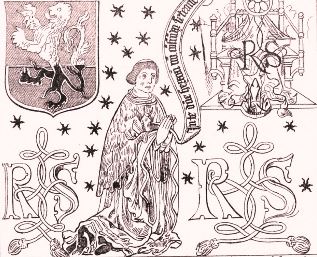
Historically the Longford County
Honours, Hereditaments, & Perquisites May Include a study of the
Following:
- Seignory of the Kingdom of
Teffia - TEABHTHA or Teamhfna – LATIN TEFFIA IS THE TERRITORY OF COUNTY
LONGFORD - south
Tethba—Tethbae District — Centered around its Capital Ardagh.[2] It was divided into two distinct
kingdoms, north Tethba, ruled by the Cenél Coirpri, and south Tethba, ruled by the Cenél
Maini
- Seignory of
the
Principality de Anghaile OR Feudal Principality of
Annaly - Princes of Anghaile , Annaly or Annalie or Chieftain and Princes of Annaly (http://www.from-ireland.net/history-longford-annaly-farrell
(also known as Conmaicne Maigh Rein)
* The Last Princes Prince of Annaly is listed
here:
Citation
- Baron Delvin of
Annaly - Chief and Captain of The Ardagh - Prince of Annaly - Tiarna or Ard
Tiarna (Lord and/or Paramont Lord) and Lord of Westmeath and
Longford or Baron Longphort - Leinster PROVINCE (Baron
of Longfoirt is a VIKING or
Irish Spelling) The Longford/Annalie Feudal Barony, Market and Fair
of the Annaly were controlled by the Baron Delvin and Lords of Westmeah. Lord Westmeath would have been the Feudal
Chief of Annaly and Baron Delvin of the Annaly Region.
- Seignory of the
Western Kingdom of Meath - Longford was the Western portion of
the Kingdom.
- Feudal Baron of
Rathline &
Cashell or Ratheline &
Cashell .
- Lord Baron of Lisnanagh Castle, Co. Longford (Capite forever). Baron Lissaghanedan/Manor Correboy in Longford
Barony. Near Longford Town and Edgeworthstown. In
grants it is spelled: Lissenoannagh Those lands created the manor of Correboymore or Coreboy, with
court leet and view of frank-pledge and court baron ; with power to appoint seneschals and other
officers, with jurisdiction in all actions for covenant and tres- pass where the damages Lios na
nUamhanach or Lisnanagh | Logainm.ie
See Map of Where Lisnanagh
Is
-
Longford Barony Market and
Fair - Grant from the King to Baron
Delvin - Longford County. License to hold a Thursday market and a fair on the 1st of August, and two days
at Longford, with the usual courts and fees
- Seignory of Kingdom of
Breifne - Longford
a province.
- Seignory of and Lord Baron
of Cairpre
Gabra- Cairpre Gabra lay between the tuaths of
Luigne-Gailenga to the east,and the Conmaicne Rein to the north-west. Centred near Granard, Cairpre Gabra lay
along the northern border of the ancient Kingdom of Meath, and comprised the barony of Granard, and at part of
the barony of Longford
- Baron
of Inchmore
or Inishmor in the
Annalie (Co Longford) Priory, Island in Lough
Gowna – Grant forever. Augustinian Priory called Inch Mór
Monastery. Forever in capite. Also, a Papal Grant of Inchmore to Baron Delvin of
Longford-Westmeath/Nugents for as long as there is a schism in the
church. See:King
James Grant of Annalie Lands and Inchmore Island &
Monestery . In this King James grant, the
monestary and the demesne of said lands in the Annalie were granted including Castle Richard
and The castle bawne town and lands of Liserdawle Lisardowlin with 8 Catrons of
land.
Despite the grant, the island obviously remained with the family for considerably longer. A further grant
recorded in the Calendar of Papal Documents relates that in 1635 the Pope permitted the Earl of Westmeath to
retain the property during the schism. The Papal grant was made on condition that if the schism should come to
an end that the earl would restore the abbeys to whatever orders had previously held them. The Nugent estates
were very considerable and quite apart from Inchmore they also held the lands of Fore which had a very large
monastic site.
- Seignory & Feudal Baron
of Upper
Conmaicne (which is county
Longford) Then the County Longford came to be known as Upper
Conmaicne, to distinguish it from Muinntir-Eolais or South Leitrim
- Feudal Lord
Baron of
Brigh
Leithe – Ancient Longford
Name (
Bri Leith)A Fief
or Seignory
- Lord or Baron of AbbeyLara or “Abbey
Larha” of Annaly & County Longford (To Nugents in Capite
forever)
- Lord or Prince of East Connaught Kingdom 1014
- Baron of Westmeath
of the Priory of Fore - 1541 - grant of the manors of
Belgard and Fore, Co. Longford-Westmeath to Nugents.
- Feudal Baron of
Moyashell or MoyasHill Moyas-Hill – Westmeath
or barony of Moyashel or Magheradernon in Westmeath. The Tuite and Marward family rights may
have been transferred over to Nugents through marriage and lack of issue.
- https://en.wikipedia.org/wiki/Moyashel_and_Magheradernon
- Chiefs and Barons of
Liserdawle - Manors/Castles of
Liserdawle, Killenlassaragh,
Moate, Grant of 1609 from King James
I - Lord Delvin owned
essentially 1/2 of Longford County which was Later Surrendered for payments of 100 Pounds
Sterling. Lord Baron
Lisserdowle (
Castle and Lands) Original Seat of the Princes and Cheifs of Annaly which is a
Feudal 'Fons Honorum' Titled
Seat.
- Baron of Skryne - Skrine Skreen Ancient
Skryne - https://en.wikipedia.org/wiki/Baron_Skryne Skryine
is a Feudal Barony inherited by Delvin Nugents by Marriage from to the last titular Baroness of the Marward
Clan.
- Feudal Lord of
Balrath & Lord of Bracklyn or Brackloom
-
Priory and Manor of Foure or Fower
. Jan.
2nd 1612 – in Capite for
Knights Service.
Lord Baron of
Belgarde & Foure & Kilthorne Manors.
-
Count Nugent - Lord of
Killasona Longford Co - & Freiherr von
Nugent
-
Graf Nugent of Longford County
-
Pope’s Grant of of Inchmore
1635
Despite the twenty year grant
the island obviously remained with the family for considerably longer. A further grant recorded in the Calendar
of Papal Documents relates that in 1635 the Pope permitted the Earl of Westmeath to retain the property during
the schism. The Papal grant was made on condition that if the schism should come to an end that the earl would
restore the abbeys to whatever orders had previously held them. The Nugent estates were very considerable and
quite apart from Inchmore they also held the lands of Fore which had a very large monastic
site.
- Lord Baron of
Coolamber Castle - Link
- Feudal Lord or
Feudal Count Palatine of Meath - The
Longford-Westmeath area was a grant in 1171 by King Henry the Second of the entire Kingdom of Meath to DeLacy
and his Barons. The Earl of Westmeath would have been the Feudal Count of
Westmeath.
- Princes of
Fiacha -
Citation
The descendants of this
Fiacha,
are the ancient tribes of MacGeoghegans of Kinallach, and the O'Molloys of Fearcall." Fiacha and McGoeghegans
were based near
Mulligar.
-
Lord Baron of Lisnanagh Castle, Co. Longford (Capite forever). Baron Lissaghanedan/Manor Correboy in Longford
Barony. Near Longford Town and Edgeworthstown. In grants
it is spelled: Lissenoannagh Those
lands created the manor of Correboymore, with court leet and view of frank-pledge and court baron ; with power
to appoint seneschals and other officers, with jurisdiction in all actions for covenant and tres- pass where
the damages Lios na nUamhanach or Lisnanagh | Logainm.ie
See Map of Where Lisnanagh Is
IX. 29.-—“ Grant under the commission for the plantation of Longford. to Thomas Nugent.—Longford County. The
town and lands
of Corroboymore, Correyboybegg, Aghenteskin, Carrickmacinleney, Fyermore, Aghencownalle, alias Aghenitanvally,
Lissenuske, Killoge, Keallragh, Clennenegenny, Lenemore, and Corlukillog, 643a. pasture, and 46a. bog and wood,
excepting thereout the lands of Ballenegoshenagh, 96a., and Ballygarnett, 296a. pasture, and 43a. bog and wood
; Cornemow, 50a. pasture, and 6a. bog and wood, barony of Longford; the castle and lands of Lissenoannagh,
113a. pasture, and 24a. bog and wood, barony of Granard ; Clonedarramner and Annaghguillen, 32a. pasture, and
298a. bog and wood; Clonfelym, Clonynbegg, Diryushy, and Derrycullin, 30a. pasture, and 137a. bog and wood,
barony of Longford. To hold 1' n capite, by military service ; rent for the l,164a. pasture, £12 2s. 6d.,
Engl., and for the 554a. bog and wood, 11s. 6%d. Those lands created the manor of Correboymore, with court leet
and view of frank-pledge and court baron; with power to appoint seneschals and other oflicers, with
jurisdiction in all actions for covenant and trespass where the damages do owt exceed 40a., Ir.; with power to
make tenures; to have free warren; to enjoy all escheats.
- Captainship and
Chief Title of Slewaght William or Clan Liam Granted to Baron Delvin by Patent - This is a
RARE and Amazing Grant of a Princely Title by the Queen of England - The Clan Liam or
Clan/Slewaght William of the Kingdom of Annaly was granted to Lord Delvin in 1565. This Captaincy or
Chieftainship of the Eastern Longford region or Country of Analy was granted to Baron Delvin
before Longford County even existed. ( Ardagh & Edgeworthstown ) Grant by the
Queen Elizabeth to Lord Delvin CHRISTOPHER NUGENT -
1565 : - Possessions and the captainship of
Slewaght (Ardagh Diocese) within the Analy were granted to Lord Devlin in 1565. (Morrin, i, 500), (Med.
religious houses, Ire., 172) the Abbey of All Saints, and the custody or captainship of Slewaght within the
Analy. Captaincy or Captainry was a high ranking hereditary title of
the time during the 1500's The Captain Title came with lands, taxes, tithes, and power and a value of 100
pounds or more. The Captain title was coveted by local Irish Princes and was exivalent to prince or Dux/Duke
during that period where the Irish referred to it as the Toshach or Leader.

- Lord Baron of St. Dominicks Abbey of
Longford. Also known as the
Longford Friary. This Abbey in the O'Farrell's Annaly was
created by Prince O'Farrell and was granted in capite
forever to Baron Delvin Richard Nugent by King Philip
and Mary
1566-7
- Baron of Columbkile
- Baron of Lerha (AbbeyLara Precinct
Grants)
- Baron of Smere
- Baron of Temple Michael
- Baron Inchcleraun
- Feudal Baron Killasonna
- Baron Skryne
- Advowson & Lordships of Granard region including churches, Advowson -
hereditiments, lordships of: Tonaghmore, Ryncole, Cowldony, Cloncrawe, Derraghe, and
Ballymanna.
Grant in Capite for Military
Service of the region of Cairbre-Gabhra including the castles, forts, messuages,
forts, churches, fisheries, and hereditaments of
four granges in Granarde, of the grange of
Tonaghmore,
of the grange of Rincolle, Cowldony,
Clontrall, and Deraghe including the site, precinct, castles, hereditments, fisheries and possessions of the
Monastary of Grenarde.
*Mentz, Seigneur of
Blondel, is a descendant of the McConnell or Mac Domnaill, McMechan
McMahon, and Fleming Clans, and this ancient land and central Irish region is part of his ancestry of which
immigrated from Ireland to the USA. Mentz comes from a long line of Scots Irish who are descendants of the
families of: Kerr, Douglas, Campbell, McConnell, Stewarts, Drummond, McMahon, McMechan, Kirkpatrick, Boyle, De
Barry, Donnel Mac Fineere Mac Carthy-Reagh, Powers, Darcy D'Arcy. FitzGerald-Leixlip, MacDonnell, Fitzjohn Barry
and many more. George Mentz, Esq., who is The Seigneur of Blondel and Lord of Stoborough and the Bailiwick of
Ennerdale is Scotish, English, German, French, Italian, Egyptian, Sicilian, Anatolian, Dravidian, Native American,
and Irish with ancestral DNA from County Dublin, County Mayo, County Galway, County Kerry, County Donegal, County
Cork and County Clare.
*
ALL AND SINGULAR Definition: A comprehensive; term often employed in conveyances, wills, and the like, which
includes the aggregate or whole and also each of the separate items or components. McClaskoy v. Ilarr (C. C.) 54
Fed. 798.https://thelawdictionary.org/all-and-singular/ * All and singular is a legal phrase meaning "each and every". It is
an antiquated term that was commonly used in making bequests under a will, and other contexts. All and Singular Law
and Legal Definition | USLegal, Inc.
https://definitions.uslegal.com/a/all-and-singular/

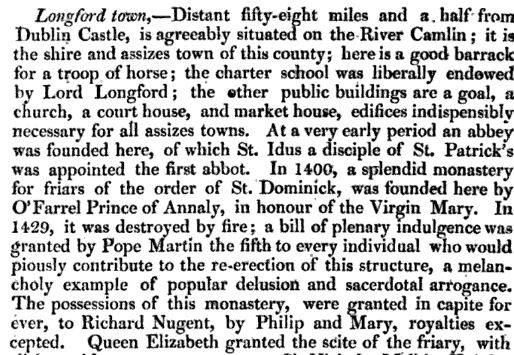
Citation Delvin
-Nugent - Early Grants in Longford from Queen Mary and King James
With the government showing little inclination to reach a more
permanent settlement with the O’Farrells, Delvin led a raid across Lough Ree shortly before Christmas 1548.21
Despite opposition from the nearby Dillons, it seems that Delvin succeeded in gaining a foothold in the southern
reaches of the O’Farrell lordship. In 1552 the crown granted the
dissolved monastery of Holy Island, Lough Ree, to the baron, together
with associated lands and tithes.22 This was more than a mundane grant of ecclesiastical land in one’s county of
residence, which many peers, gentry and officials received: it must be viewed in the context of mid-Tudor
expansionism. The government was willing in 1553 to nominate a ‘captain and governor’ of the O’Farrell Boy branch,
yet allowed Delvin to build up a landholding profile within the branch’s sphere of influence on the banks of Lough
Ree. Lord Deputy Croft and his advisors described these lands as in ‘a waste, wylde Countrey amonge the yrishe
where lytle obedyence doth contynue’, but Delvin had announced his intention to fortify his new
territory.23
The baron was also granted the monastic site at Granard, in the
northeast of the Annaly lordship; this also represented a projected expansion of English influence. Before the 15th
century Granard Abbey had been an exclusively English foundation, but papal order forced it to admit Gaelic men.
The house quickly lost its English identity, and fell completely under O’Farrell patronage.24 Thus Delvin’s
acquisition of Granard represented an effort to reincorporate former English church lands into English society.
Confirmation of the achievements of Baron Richard in enhancing the importance of his house came in 1553, when he
joined O’Connor Roe in a devastating raid on the MacDermots of Moylurg, a lordship situated west of the Annaly and
a considerable distance from Delvin territory.25
County Longford Monastery of Holy Island Lough Ree also
Granted to Lord Delvin in 1552
Citation
ANNALY, OR LONGFORD - Principality of
Annaly
Anghaile or "Annaly," which was formed out of the ancient territory of Teffia
(Latin), comprised the whole of the County Longford, and was the principality of O'Farrell. His chief residence was
the town of "Longford," anciently called Longphort-Ui-Fhearghail or the Fortress of O'Farrell. This territory was
divided into Upper and Lower Annaly: the former comprising that part of Longford south of Granard, and a part of
the County Westmeath, was possessed by O'Farrell Buidhe (or O'Farrell the Yellow); the latter, or that portion
north of Granard, was possessed by O'Farrell Ban (or O'Farrell the Fair). The O'Farrells were dispossessed of this
territory by Hugh de Lacy in the twelfth century.
De LACY TO THEIR KNIGHTS.
This victory at Thurles gave new courage to the Irish, as it was the first pitched
battle they had won against the invaders; and now, in this year 1174, "taking head from O'Brien's success, they
sprang up on all sides, and the earl could not move from Waterford."* Even there he was not long safe, for the
citizens, exasperated by the licentiousness of the soldiery developed during Raymond's command, rose in arms and
killed 200 of the English garrison, and Strongbow was obliged to betake himself to an island near the
town.f
Hugh De Lacy had been parcelling out his seigniory of Meath, including the country to
the banks of the Liffey, among the knights and lords who accompanied him, and they had taken pains to consolidate
their settlement by the importation of men and arms, and the erection of numerous castles. To his true friend Hugh
Tyrrell, De Lacy had presented Castleknock; and to William Petit, Castlebrack; to Gilbert De Nangle and his son
Jocelyn, a great tract of country; to Richard Tuite, " fair possessions;" to Richard De La Chappell, "much land;"
to Adam De Feipo the domains of Skryne, Clontarf, and Santry; to Gilbert De Nugent, the territory of Delvin; to
William De Misset and Hugh De Hose, or Hussey," large inheritances;" to Geoffrey De Constantine, lands in
O'Ferral's country of Annaly; to Thomas Le Fleming, Ardee; to "the valiant Meyler Fitz-Henry," to Robert De Lacy,
to AdamDullard, to " one Thomas," and to Richard Le Fleming, large tracts also.*
To learn more, read the
Baronage of Ireland
The original Westmeath contained
Longord County and also people of Delbna/Delvin.
The Original Grant by Hugh de Lacy
to Gilbert de Nugent included all of the lands of Delvin or Delbhna. These Delvin tribes
and clans of O'Fenolen or O'Finnallan existed in all of Westmeath and outside of
Westmeath.

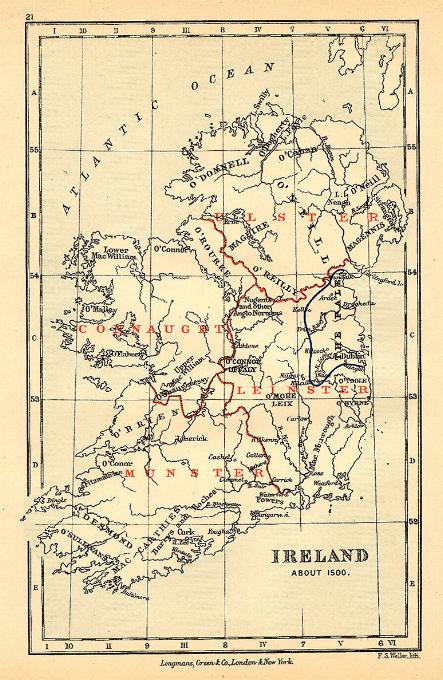

Elizabeth R. 56. The
Queen to the Lord Deputy and the Lord Chancellor.
“Right trustie and well beloved, we greet you well: we are pleased
to grant to our right trustie and well beloved, the Baron of Delvin, his heirs and assigns, in fee-farm, our
castles, manors, lands, tenements, tithes, and other hereditaments whatsoever, which shall be found by office
(inquisition), or other sufficient matter of recorde, to have been the possessions and lands of such persons as
have been slayne in actual rebellion against us, sithence the twentieth
day of June, in the five-and-thirtieth year of our reign, or of such rebels as hereafter shall be attainted for
like cause, and situate in the Country of Breny, called the countie
of Cavan, or in the
countrie of the Anally, called the countie of Longforde, or in both, amounting to the cleare yearly
value of one hundred pounds of lawful money of England, at the
choice of the Baron, his heirs and assigns, if the same shall be
by you thought meete to be passed from us, and not found fit to be reserved in our hands for the use of any
garrison or fortification; according to such rents, compositions, and services, as the premises shall appear
to have been heretofore helde of us, if any suche shall be founde upon the records of our Exchequer, or else
upon reasonable survey to be taken for us, according to the course of our Exchequer in like cases; wherefore
our will and pleasure is, and we do authorize and require you, when the Lord of Delvin, his heirs or assigns,
or any for him or them, shall bringe unto you any note or notes of any such lands or hereditaments in the
counties of Cavan and Longford, then ye shall give him, his heirs and assigns, means, from time to time, to have the just
particulars thereof at the hands of our auditor there; and thereupon cause, by advice of our learned
Council, one or more books of so much of the castles,
manors, lands, tenements, tithes, and hereditaments, as shall amount to the value of
£1oo, current money of England, in the counties of Cavan
and Longford, to be granted from us, our
heirs and successors, in fee-farm, to the said Lord of Delvin, his heirs and assigns for
ever, by letters
patent under our Great Seal of Ireland ; reserving to us,
our heirs and successors, such rents, compositions, and services yearly, as shall be founde by office,
survey, or recorde, to have been heretofore paid, or to be hereafter meete to be reserved for any of the said
lands and hereditaments, proportionably to the quantity of the lands and hereditaments, unto us or our
predecessors; To be holden of us, our heirs and successors, by knight's
service, in capite ; with a provisoe to be inserted in such
letters patent of the lands to be made to the Baron,
that he shall not alienate them, or any part of them, to any of the meere Irishrie or others, who shall not
be of English descent; and also we require you, our Council, the Barons of the Exchequer, and all other our
officers, to whom it shall appertain, to further the Baron, his heirs and assigns, in the expedition of this
our grant : further, for that we have been advertized by you of the chargeable and valorous service of the
Baron, during the late rebellion, and of his sufficiencye therein to do us service, and as we understand from
him, that for the prosecution of the rebells, which we intend, our forces must be used and employed in his
country, we do, therefore, thiuk it fit, and so require you, that of our forces which shall be in our pay,
some parte may be assigned to his charge and governmente, either of horse or foote, as you, with the advice
of our Council, shall find to be answerable to his degree, ability, and good deserte.”—Palace of Westminster,
May 7, 39°.
Memorandum of the Lord Baron of Delvin, having on the 1st of June, in the year
aforesaid, come before the Master of the Rolls, and having prayed that the preceding letter should be enrolled, it
was accordingly ordered by— A. Sentleger.
Membrane 7.
Elizabeth R.
1597
Citation
Writs and Summons of the: Barons/Lord
of Westmeath/Annaly and Longford to Attend Parliament
- 1371, John Fitz John (Baron of Delvin) was summoned
to Parliament by Writ, dated at Dublin, 13th February in that Year, as Baron of
Delvin:
- Later, Sir William Nugent was summoned to Parliament by
Writ as Baron of Delvin, and is commonly called the First Baron of Delvin:
- Christopher the 6th Baron of Delvin, who sat in the
Parliament which was held at Trim in the Reign of Richard 3d:
- Christopher was the Eighth Baron Delvin, sat in Parliament
20th Elizabeth, and died on the 17th August 1602.
- Richard the Ninth Baron of Delvin sat in Parliament in
1613 and in 1615, and by Privy Seal, dated at Westminster, 22d November 1621, he was (144.) created created
Earl ofWestmeath, to him and the Heirs Male of his Body.
Below is one of
the Barony Grants by King James - Including Grants in Fee Simple of: The Holy
Island in Annaly, the tithes of the lands of Rathline and Cashell and tithes and rectories of the region. Castle of
Monilagan or Babington, Castle and Moiety of of Newton, Island of Cloning, Lands of the Abbey of Larha, Castle of
Lisnevoa.
Grants to Hold in fee farm forever in common soccage and to
maintain two horseman/knights from the Pale for the defence of the kingdom.
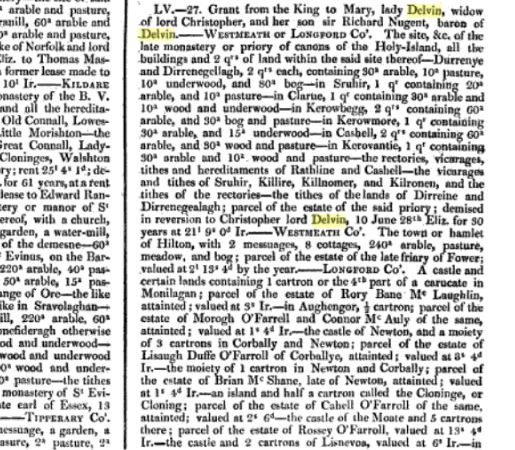


Citations of Patent Rolls
The clause in the 1996 Deed of Transfer is
legally significant because it confirms that the property conveyed — the Feudal Barony or Honour of Longford — is not land but an incorporeal hereditament, and therefore exempt from Section 112 of the Finance Act 1940. That Act imposes stamp duties and
taxes on the transfer of land and interests in land; however, a feudal barony is a title of dignity and jurisdiction, not a physical estate. It is a remnant of the
medieval system of landholding, existing today as an intangible right of honour and precedence. By
certifying that the Finance Act does not apply, the deed establishes that this transaction concerns the
transfer of a feudal dignity, not a conveyance of real property. This protects the
purchasers from unnecessary property tax liabilities and ensures the barony’s treatment as a distinct legal
entity — a heritable noble title rather than taxable land. The clause also provides evidence
that the Irish Registry of Deeds recognized the conveyance as a lawful transfer of a feudal title in fee simple, reinforcing the continuity of the
barony’s legal existence as a juridical honour, independent of any land or manor once attached to
it.
|


